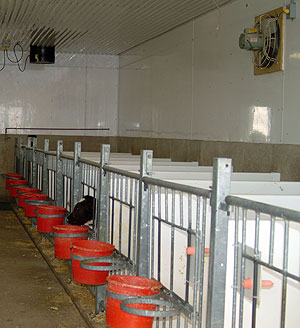Creating the ideal environment for calf health is a challenge, and somewhat of a contradiction. While it is important to separate young, vulnerable calves from sources of disease, housing methods to accomplish this can negatively impact ventilation, increasing the risk for bovine respiratory disease (BRD). While a previous edition of Calf Care Corner focused on managing early calf health to minimize susceptibility to BRD, this edition will explore the role of housing and ventilation as they contribute to BRD.
Adequate ventilation is critical for removing organisms and humidity from the air. When relative humidity exceeds 80%, bacteria can survive significantly longer. However, dead bacteria can also act as an irritant to the respiratory tract (Wathes et al. 1983). Increased humidity can be seen in housing where flooring allows urine and water to accumulate. Keep in mind that calves on automatic feeders will consume more milk and free choice water, and will require more bedding to keep dry. It is recommended to bed for 20-25lbs/calf initially, and then 2-3lbs/d afterwards; 1lb/d may be common, but is insufficient to soak up urine (Ziegler and Chester-Jones 2011). Otherwise, ammonia levels can rise, contributing to respiratory problems.
Housing and Ventilation Types
Consider how different housing types affect ventilation quality in your calf barn. You may be looking to build a new facility, or you may want to consider how these factors contribute to the current incidence of BRD in your calves.
Negative pressure ventilation: for air to mix and distribute properly, adequate airflow must be achieved. If there are any undetected openings around walls or windows in a negative pressure facility, airflow will drastically drop, and ventilation will be poor.
Natural ventilation: relies on external wind forces and thermal buoyancy. In the summer, prevailing winds may be too slow to achieve sufficient mixing (especially if there are obstructions within the barn), and dead pockets of air can occur that are often highly polluted. This ventilation can also be challenging in the wintertime; barns need to be several degrees above the outside temperature to facilitate air movement. However, calves themselves do not produce enough heat to significantly contribute to this effect of thermal buoyancy. This, in conjunction with closed curtains may minimize ventilation in the winter.
Recent research compared 13 naturally ventilated calf barns in the summer. It was found that bacterial counts in the barn alleys were associated with ventilation rate, but individual pen bacterial counts were highly variable, and independent of barn ventilation rate (Lago et al. 2006). This type of data demonstrates that individual pens have their own “microenvironments”, which can be highly polluted.
Risk Factors
This study also reported 3 factors to be associated with a decreased incidence of BRD:
- Use of a solid barrier between pens
- Increased ability to nest
- Decreased bacterial counts
However, factors that were associated with decreased bacterial counts demonstrate the challenge in calf housing. While it is recommended that there be a solid barrier between pens to reduce pathogen transfer (and nose-to-nose contact), an increased number of sides results in increased bacterial counts. Thus, it is recommended that calf pens only have two solid sides. Attempts to fully enclose the pen to reduce thermal stress is not the best option; if adequate bedding is provided, calves are able to thermoregulate with only two solid sides.
The study reported several factors associated with decreased bacterial counts:
- Lower pen temperature
- Increased pen size
- Fewer solid sides
- Supplemental calf ventilation
Positive pressure ventilation can provide very small amounts of air to each pen and improve the microenvironment without causing a draft. Positive pressure ventilation can complement natural or negative pressure ventilation barns as well, particularly in the challenging winter months.
For any housing type, keep the basic principles of ventilation in mind. While group pens may eliminate pen microenvironments, sufficient mixing of air still needs to occur to remove organisms and humidity. Be aware of any draft-free areas within your barn. Consider the stocking density of your calves as well, as it heavily influences bacterial counts (Nordlund 2011). In fact, even newborn calves produce 1L of moisture each day through respiration, contributing to humidity levels.
Make sure your calves are getting the fresh air they need, and enough bedding to keep them dry and warm.
